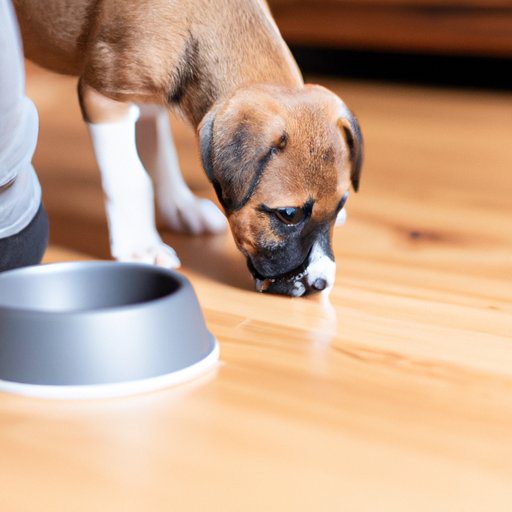
Introduction
Getting a new puppy can be an exciting time, but with it comes the responsibility of house training your new furry friend. House training a puppy may seem daunting at first, but with time, patience, and consistency, it can be a successful endeavor. In this article, we will provide an in-depth guide to house training a puppy, covering everything from dos and don’ts to tools and products that can make the process easier.
Step-by-Step Guide to House Training a Puppy
Consistency in training is key when it comes to house training a puppy. Stick to a routine and ensure everyone in the household is on the same page. Here is a step-by-step guide to house training your puppy:
Crate training
Crate training is an effective way to help teach your puppy bladder and bowel control. It is important to properly introduce your puppy to their crate and make it a comfortable and safe space. Gradually increase the amount of time your puppy spends in their crate, but avoid leaving them in there for long periods of time.
Frequent outdoor trips
Taking your pup outside frequently throughout the day will help them understand that outside is where they are supposed to do their business. Be consistent with when you take them out, such as after meals, naps, and playtime.
Rewards for good behavior
Positive reinforcement is crucial when it comes to house training a puppy. When your puppy goes potty in the designated area, give them praise and a treat. This will help them associate going potty outside with rewards and positive experiences.
Dos and Don’ts of House Training a Puppy
Avoid these common mistakes when house training your puppy:
Do be patient
House training a puppy takes time and patience. Don’t expect immediate results and be prepared for accidents to happen.
Provide a designated potty spot
Your puppy needs to know where they are supposed to go potty. Designate one spot outside and consistently take them there.
Set up a routine
Your puppy will learn faster if you have a consistent routine for them to follow. Be consistent with when you take them outside, feed them, and give them water.
Don’t punish your puppy for accidents
Never punish your puppy for having an accident inside. This will only teach them to fear you and could lead to more accidents in the future.
Don’t expect immediate results
House training a puppy takes time and dedication. Don’t get discouraged if progress seems slow, keep at it and your patience will pay off.
Tools and Products to Aid in House Training
Certain tools and products can make the house training process easier:
Pee pads
Pee pads can be useful for puppies who are not yet able to hold their bladder for long periods of time. Place them in a designated spot and gradually move them closer to the door until your puppy is ready to go outside.
Treat incentives
Treats can be a great tool for positive reinforcement when your puppy goes potty outside. Make sure to choose healthy puppy treats.
Odor eliminators
Accidents will happen during the training process. Use an odor eliminator to clean up any messes and reduce the chances of your puppy going in the same spot again.
Potty Training Games
Make the potty training process fun for your puppy by incorporating games and activities:
– Hide and seek: Hide treats in the designated potty spot to encourage your pup to go there.
– Fetch: Play a quick game of fetch outside after your puppy goes potty.
– Sniffing games: Use different scents, like pepper or rosemary, to create a potty area that your puppy will be more likely to use.
Finding the Right Time to House Train a Puppy
When to start house training your puppy is an important consideration:
Time off work
Plan to start house training when you have a few days off work. This will allow you to focus on the training process and avoid accidents while you’re away.
Weather
With extreme temperatures, potty breaks can quickly become uncomfortable or dangerous for your puppy. Plan to start training during mild weather conditions.
Troubleshooting Common Problems
Be prepared to run into some common house training issues and follow these helpful tips:
Accidents in the house
If your puppy has an accident inside, clean it up thoroughly with an odor eliminator, and avoid punishing your puppy. Stick to a consistent routine and ensure your puppy is taken outside regularly.
Excessive barking
Excessive barking can be frustrating. Avoid scolding your puppy and opt for positive reinforcement through treats and praise when they’re quiet.
Confusion about the designated potty spot
Your puppy may not immediately understand where they are supposed to go potty. Stay consistent with taking them to the same spot and using the same command, like “go potty.”
Benefits of House Training a Puppy
The benefits of a well-trained puppy are numerous:
A cleaner home
A successfully house-trained puppy means less messes in your home.
A stronger bond with your puppy
By working closely with your puppy during the house training process, a stronger bond can be created.
Fewer behavioral issues down the road
A well-trained puppy will likely experience fewer long-term behavioral issues.
Conclusion
House training a puppy can be a challenging process, but with patience and consistency, it can be successful. Stick to a strict routine, use positive reinforcement, and consider utilizing tools and products like pee pads and odor eliminators. With some time and dedication, a well-trained puppy will be worth the effort.




